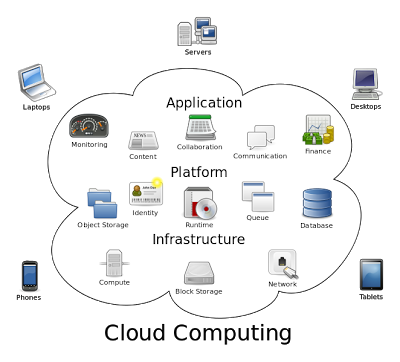The Internet has been represented by the symbol cloud for years. In any meetings or presentations, the cloud has always been the symbol of the internet.
The name cloud computing originated from the same representation. It was coined by an Indian. There are many definitions available over the internet for cloud computing.
Simply put, cloud computing is the delivery of computing as a service rather than a product. Be it a network, storage, server, or platform, everything is delivered as a service like we use electricity in our homes.
In cloud computing, IT-related capabilities are provided to users as a material service over the network. It means all IT-related functionality can be used just using a computer and an internet connection.
Why cloud computing?
There is an unquenchable thirst for collaboration and sharing. We can work anywhere at any time. You can work at home, travel, etc.
You have to pay for whatever resources you want to use. For instance, let's say you want to open up a website for a campaign for the presidential election. So the website will be alive for a few months. you might receive unexpected traffic to the website.
In such a case there is a chance of a website crash if you go with traditional hosting services since it can't scale out based on the increase in requests...
The main reason is, that traditional hosting services provide hosting with fixed storage and bandwidth, scaling in and out is a tedious process. Here is where cloud computing comes into play.
Cloud servers can scale out according to your needs. You have to pay for the resources you use. You can stop and start the services wherever needed.
Unlike traditional hosting services, you have to pay only when your services are up and running. So all we need is a less cost-oriented computing service that makes life easy.
The approach of cloud computing helps us in order to attain such service over the internet. There are many services provided by public cloud providers over the internet. A few are shown below
- Database as a service
- API as a service
- Security as a service
- CRM as a service
- Desktop as a service
- Testing environment as a service etc….
Every cloud service comes under one category mentioned below
- IaaS(Infrastructure as a service)
- PaaS(platform as a service)
- SaaS(Software as a service or software as a service)

Infrastructure as a service (Iaas)
Infrastructure as a service is the backbone of cloud computing. It lets you deploy servers using Windows and Linux distros in minutes. Your servers will be up and running in just minutes.
Each and every IT infrastructure is virtualized and provided as a server over the Internet. Amazon is the leading IaaS provider. Amazon provides virtual servers, databases, storage networks, etc..
These services can be deployed without much programming language.
Platform as a service (PaaS)
With cloud services, the investment of millions of dollars on development foundations is reduced by providing a platform as a service over the network.
PaaS will provide the platform on the web. Cost and complexity are very much reduced by the PaaS provider.
With a platform as a service, you don't have to worry about the underlying infrastructure. The PaaS platform will take care of hosting and scaling your applications.
Following are some of the examples of PaaS services.
- Google App Engine
- AWS Elastic Beanstalk
- Red Hat OpenShift PaaS
- Heroku
- Engine Yard
- MongoDB Atlas (Database)
Software as a Service (SaaS)
Let's say, you want software that will be used by your company only once or twice a month and it costs 5,000 dollars. Our friend has a cloud service that offers the same software through the web which will be billed on an hourly basis and you have to pay only for what have you used.
So that you can stop the service if not needed. With this approach, you can use software that is too expensive to buy for testing purposes. Medium-sized businesses benefit from this service since they can't afford to use all the expensive software.
All they need is a computer, browser, and network connection. It eliminates the need to install and run applications on the customer's own computers. SalesForce.com is a great example of Software as a Service. They offer CRM solutions and databases as a service over the Internet. Just using any mobile device that has a browser can access the services.
Here are some of the best examples of software as a service.
- Zoho
- Canva (Imaging editing app)
- Amazon Workspaces (Provided virtual desktops)
Conclusion
Apart from IaaS, PaaS, and SaaS, many cloud terminologies evolved.
However, Infrastructure, platform, and software remain the base of any cloud computing service.
Also, huge developments happened over public and private cloud platforms that come with well-equipped automation, high availability, and several managed services that make end-users' life easy.

